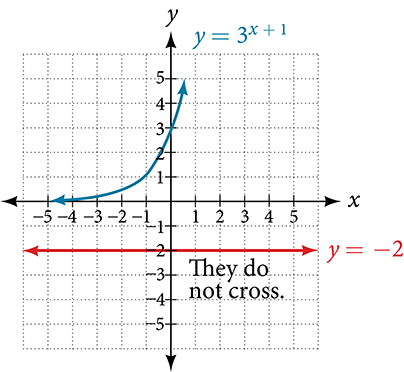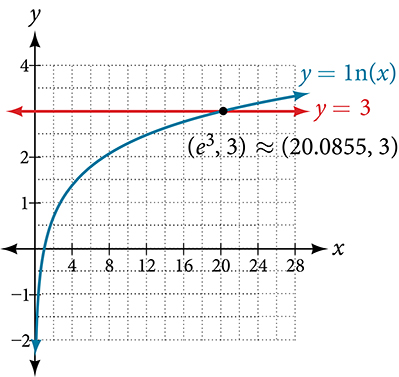Section 6.4 – Exponential and Logarithmic Equations
Learning Objectives
Welcome to Section 6.4! In this section you will...
- Use like bases to solve exponential equations.
- Use logarithms to solve exponential equations.
- Use the definition of a logarithm to solve logarithmic equations.
- Use the one-to-one property of logarithms to solve logarithmic equations.
- Solve applied problems involving exponential and logarithmic equations

In 1859, an Australian landowner named Thomas Austin released 24 rabbits into the wild for hunting. Because Australia had few predators and ample food, the rabbit population exploded. In fewer than ten years, the rabbit population numbered in the millions.
Uncontrolled population growth, as in the wild rabbits in Australia, can be modeled with exponential functions. Equations resulting from those exponential functions can be solved to analyze and make predictions about exponential growth. In this section, we will learn techniques for solving exponential functions.
Using Like Bases to Solve Exponential Equations
The first technique involves two functions with like bases. Recall that the one-to-one property of exponential functions tells us that, for any real numbers [latex]b[/latex], [latex]S[/latex], and [latex]T[/latex], where [latex]b>0[/latex], [latex]b≠1[/latex], [latex]b^S=b^T[/latex] if and only if [latex]S=T[/latex].
In other words, when an exponential equation has the same base on each side, the exponents must be equal. This also applies when the exponents are algebraic expressions. Therefore, we can solve many exponential equations by using the rules of exponents to rewrite each side as a power with the same base. Then, we use the fact that exponential functions are one-to-one to set the exponents equal to one another, and solve for the unknown.
For example, consider the equation [latex]3^{4x−7}=\frac{3^{2x}}{3}[/latex]. To solve for [latex]x[/latex], we use the division property of exponents to rewrite the right side so that both sides have the common base, [latex]3[/latex]. Then we apply the one-to-one property of exponents by setting the exponents equal to one another and solving for [latex]x[/latex]:

Using the One-to-One Property of Exponential Functions to Solve Exponential Equations
For any algebraic expressions [latex]S[/latex] and [latex]T[/latex], and any positive real number [latex]b≠1[/latex],
How To
Given an exponential equation with the form [latex]b^S=b^T[/latex], where [latex]S[/latex] and [latex]T[/latex] are algebraic expressions with an unknown, solve for the unknown.
- Use the rules of exponents to simplify, if necessary, so that the resulting equation has the form [latex]b^S=b^T[/latex].
- Use the one-to-one property to set the exponents equal.
- Solve the resulting equation, [latex]S=T[/latex], for the unknown.
Example 1
Solving an Exponential Equation with a Common Base
Solve [latex]2^{x−1}=2^{2x−4}[/latex].
Show/Hide Solution
Solution

Try It #1
Solve [latex]5^{2x}=5^{3x+2}[/latex].
Rewriting Equations So All Powers Have the Same Base
Sometimes the common base for an exponential equation is not explicitly shown. In these cases, we simply rewrite the terms in the equation as powers with a common base, and solve using the one-to-one property.
For example, consider the equation [latex]256=4^{x−5}[/latex]. We can rewrite both sides of this equation as a power of [latex]2[/latex]. Then we apply the rules of exponents, along with the one-to-one property, to solve for [latex]x[/latex]:

How To
Given an exponential equation with unlike bases, use the one-to-one property to solve it.
- Rewrite each side in the equation as a power with a common base.
- Use the rules of exponents to simplify, if necessary, so that the resulting equation has the form [latex]b^S=b^T[/latex].
- Use the one-to-one property to set the exponents equal.
- Solve the resulting equation, [latex]S=T[/latex], for the unknown.
Example 2
Solving Equations by Rewriting Them to Have a Common Base
Solve [latex]8^{x+2}=16^{x+1}[/latex].
Show/Hide Solution
Solution

Try It #2
Solve [latex]5^{2x}=25^{3x+2}[/latex].
Example 3
Solving Equations by Rewriting Roots with Fractional Exponents to Have a Common Base
Solve [latex]2^{5x}=\sqrt{2}[/latex].
Show/Hide Solution
Solution

Try It #3
Solve [latex]5^x=\sqrt{5}[/latex].
Q&A
Do all exponential equations have a solution? If not, how can we tell if there is a solution during the problem-solving process?
No. Recall that the range of an exponential function is always positive. While solving the equation, we may obtain an expression that is undefined.
Example 4
Solving Equations by Rewriting Fractional Bases to Have a Common Base
Solve [latex](\frac{1}{64})^{3n} \cdot 8=2^6[/latex].
Show/Hide Solution
Solution
We begin by rewriting any fractional bases to have a common base. Since [latex]a^{-x}=\frac{1}{a^x}[/latex] and [latex]2^6=64[/latex], then [latex]\frac{1}{64}=\frac{1}{2^6}=2^{-6}[/latex]. Thus,
[latex](\frac{1}{64})^{3n} \cdot 8=2^6 ⇒ (2^{-6})^{3n} \cdot 8=2^6[/latex]
Next, in order to take a power of a power, we multiply the exponents.
[latex]( 2^{-6})^{3n} \cdot 8=2^6 ⇒ 2^{-18n} \cdot 8=2^6[/latex]
Similarly, we know that [latex]2^3=8[/latex]. So we can rewrite the entire equation with a common base.
[latex]2^{-18n} \cdot 8=2^6 ⇒ 2^{-18n} \cdot 2^3=2^6[/latex]
Then, we use the product rule of exponents.
[latex]2^{-18n} \cdot 2^3=2^6 ⇒ 2^{-18n+3}=2^6[/latex]
Using the one-to-one property, we set the exponents to be equal.
[latex]2^{-18n+3}=2^6 ⇒ -18n+3=6[/latex]
Finally, we solve for x.
[latex]-18n+3=6 ⇒ -18n=3 ⇒ n=\dfrac{3}{-18}=-\dfrac{1}{6}[/latex]
Example 5
Solving an Equation with Positive and Negative Powers
Solve [latex]3^{x+1}=−2[/latex].
Show/Hide Solution
Solution
This equation has no solution. There is no real value of [latex]x[/latex] that will make the equation a true statement because any power of a positive number is positive.
Analysis
Figure 2 shows that the two graphs do not cross so the left side is never equal to the right side. Thus the equation has no solution.

Try It #4
Solve [latex]2^x=−100[/latex].
Solving Exponential Equations Using Logarithms
Sometimes the terms of an exponential equation cannot be rewritten with a common base. In these cases, we solve by taking the logarithm of each side. Recall, since [latex]log(a)=log(b)[/latex] is equivalent to [latex]a=b[/latex], we may apply logarithms with the same base on both sides of an exponential equation.
How To
Given an exponential equation in which a common base cannot be found, solve for the unknown.
- Apply the logarithm of both sides of the equation.
- If one of the terms in the equation has base 10, use the common logarithm.
- If none of the terms in the equation has base 10, use the natural logarithm.
- Use the rules of logarithms to solve for the unknown.
Example 6
Solving an Equation Containing Powers of Different Bases
Solve [latex]5^{x+2}=4^x[/latex].
Show/Hide Solution
Solution

Try It #5
Solve [latex]2^x=3^{x+1}[/latex].
Q&A
Is there any way to solve [latex]2^x=3^x[/latex]?
Yes. The solution is [latex]0[/latex].
Equations Containing e
One common type of exponential equations are those with base [latex]e[/latex]. This constant occurs again and again in nature, in mathematics, in science, in engineering, and in finance. When we have an equation with a base [latex]e[/latex] on either side, we can use the natural logarithm to solve it.
How To
Given an equation of the form [latex]y=Ae^{kt}[/latex], solve for [latex]t[/latex].
- Divide both sides of the equation by [latex]A[/latex].
- Apply the natural logarithm of both sides of the equation.
- Divide both sides of the equation by [latex]k[/latex].
Example 7
Solve an Equation of the Form [latex]y=Ae^{kt}[/latex]
Solve [latex]100=20e^{2t}[/latex].
Show/Hide Solution
Solution

Analysis
Using laws of logs, we can also write this answer in the form [latex]t=ln\sqrt{5}[/latex]. If we want a decimal approximation of the answer, we use a calculator.
Try It #6
Solve [latex]3e^{0.5t}=11[/latex].
Q&A
Does every equation of the form [latex]y=Ae^{kt}[/latex] have a solution?
No. There is a solution when [latex]k≠0[/latex], and when [latex]y[/latex] and [latex]A[/latex] are either both 0 or neither 0, and they have the same sign. An example of an equation with this form that has no solution is [latex]2=−3e^t[/latex].
Example 8
Solving an Equation That Can Be Simplified to the Form [latex]y=Ae^{kt}[/latex]
Solve [latex]4e^{2x}+5=12[/latex].
Show/Hide Solution
Solution

Try It #7
Solve [latex]3+e^{2t}=7e^{2t}[/latex].
Extraneous Solutions
Sometimes the methods used to solve an equation introduce an extraneous solution, which is a solution that is correct algebraically but does not satisfy the conditions of the original equation. One such situation arises in solving when the logarithm is taken on both sides of the equation. In such cases, remember that the argument of the logarithm must be positive. If the number we are evaluating in a logarithm function is negative, there is no output.
Example 9
Solving Exponential Functions in Quadratic Form
Solve [latex]e^{2x}−e^x=56[/latex].
Show/Hide Solution
Solution

Analysis
When we plan to use factoring to solve a problem, we always get zero on one side of the equation, because zero has the unique property that when a product is zero, one or both of the factors must be zero. We reject the equation [latex]e^x=−7[/latex] because a positive number never equals a negative number. The solution [latex]ln(−7)[/latex] is not a real number, and in the real number system this solution is rejected as an extraneous solution.
Try It #8
Solve [latex]e^{2x}=e^x+2[/latex].
Q&A
Does every logarithmic equation have a solution?
No. Keep in mind that we can only apply the logarithm to a positive number. Always check for extraneous solutions.
Using the Definition of a Logarithm to Solve Logarithmic Equations
We have already seen that every logarithmic equation [latex]log_b(x)=y[/latex] is equivalent to the exponential equation [latex]b^y=x[/latex]. We can use this fact, along with the rules of logarithms, to solve logarithmic equations where the argument is an algebraic expression.
For example, consider the equation [latex]log_2(2)+log_2(3x−5)=3[/latex]. To solve this equation, we can use rules of logarithms to rewrite the left side in compact form and then apply the definition of logs to solve for [latex]x[/latex]:

Using the Definition of a Logarithm to Solve Logarithmic Equations
For any algebraic expression [latex]S[/latex] and real numbers [latex]b[/latex] and [latex]c[/latex], where [latex]b>0[/latex], [latex]b≠1[/latex],
Example 10
Using Algebra to Solve a Logarithmic Equation
Solve [latex]2lnx+3=7[/latex].
Show/Hide Solution
Solution

Try It #9
Solve [latex]6+lnx=10[/latex].
Example 11
Using Algebra Before and After Using the Definition of the Natural Logarithm
Solve [latex]2ln(6x)=7[/latex].
Show/Hide Solution
Solution

Try It #10
Solve [latex]2ln(x+1)=10[/latex].
Example 12
Using a Graph to Understand the Solution to a Logarithmic Equation
Solve [latex]lnx=3[/latex].
Show/Hide Solution
Solution
![]()
Figure 3 represents the graph of the equation. On the graph, the x-coordinate of the point at which the two graphs intersect is close to 20. In other words [latex]e^3≈20[/latex]. A calculator gives a better approximation: [latex]e^3≈20.0855[/latex].

Try It #11
Use a graph to find the solution to the logarithmic equation [latex]2^x=1000[/latex], then use a a calculator to estimate the approximation to 2 decimal places.
Using the One-to-One Property of Logarithms to Solve Logarithmic Equations
As with exponential equations, we can use the one-to-one property to solve logarithmic equations. The one-to-one property of logarithmic functions tells us that, for any real numbers [latex]x>0[/latex], [latex]S>0[/latex], [latex]T>0[/latex] and any positive real number [latex]b[/latex], where [latex]b≠1[/latex],
For example,
So, if [latex]x−1=8[/latex], then we can solve for [latex]x[/latex], and we get [latex]x=9[/latex]. To check, we can substitute [latex]x=9[/latex] into the original equation: [latex]log_2(9−1)=log_2(8)=3[/latex]. In other words, when a logarithmic equation has the same base on each side, the arguments must be equal. This also applies when the arguments are algebraic expressions. Therefore, when given an equation with logs of the same base on each side, we can use rules of logarithms to rewrite each side as a single logarithm. Then we use the fact that logarithmic functions are one-to-one to set the arguments equal to one another and solve for the unknown.
For example, consider the equation [latex]log(3x−2)−log(2)=log(x+4)[/latex]. To solve this equation, we can use the rules of logarithms to rewrite the left side as a single logarithm, and then apply the one-to-one property to solve for [latex]x[/latex]:

To check the result, substitute [latex]x=10[/latex] into [latex]log(3x−2)−log(2)=log(x+4)[/latex].

Using the One-to-One Property of Logarithms to Solve Logarithmic Equations
For any algebraic expressions [latex]S[/latex] and [latex]T[/latex] and any positive real number [latex]b[/latex], where [latex]b≠1[/latex],
Note, when solving an equation involving logarithms, always check to see if the answer is correct or if it is an extraneous solution.
How To
Given an equation containing logarithms, solve it using the one-to-one property.
- Use the rules of logarithms to combine like terms, if necessary, so that the resulting equation has the form [latex]log_bS=log_bT[/latex].
- Use the one-to-one property to set the arguments equal.
- Solve the resulting equation, [latex]S=T[/latex], for the unknown.
Example 13
Solving an Equation Using the Rules of Logarithms
Solve [latex]log(x+3)-log(x)=log(74)[/latex].
Show/Hide Solution
Solution
First, we apply the quotient rule of logarithms.
[latex]log(x+3)-log(x)=log(74) ⇒ log(\frac{x+3}{x})=log(74)[/latex]
Then, we apply the one-to-one property of a logarithm.
[latex]log(\frac{x+3}{x})=log(74) ⇒ \dfrac{x+3}{x}=74[/latex]
Now, we multiply both sides of the equation by x and solve the equation.
[latex]\frac{x+3}{x}=74 ⇒ x+3=74x ⇒ 3=74x-x ⇒ 3=73x ⇒ x=\dfrac{3}{73}[/latex]
Analysis
Substitute the solution back into the equation to check for any extraneous solutions.
Example 14
Solving an Equation Using the One-to-One Property of Logarithms
Solve [latex]ln(x^2)=ln(2x+3)[/latex].
Show/Hide Solution
Solution

Analysis
There are two solutions: [latex]3[/latex] or [latex]−1[/latex]. The solution [latex]−1[/latex] is negative, but it checks when substituted into the original equation because the argument of the logarithm functions is still positive.
Try It #12
Solve [latex]ln(x^2)=ln1[/latex].
Solving Applied Problems Using Exponential and Logarithmic Equations
In previous sections, we learned the properties and rules for both exponential and logarithmic functions. We have seen that any exponential function can be written as a logarithmic function and vice versa. We have used exponents to solve logarithmic equations and logarithms to solve exponential equations. We are now ready to combine our skills to solve equations that model real-world situations, whether the unknown is in an exponent or in the argument of a logarithm.
One such application is in science, in calculating the time it takes for half of the unstable material in a sample of a radioactive substance to decay, called its half-life. Table 1 lists the half-life for several of the more common radioactive substances.
|
Substance |
Use |
Half-life |
|
gallium-67 |
nuclear medicine |
80 hours |
|
cobalt-60 |
manufacturing |
5.3 years |
|
technetium-99m |
nuclear medicine |
6 hours |
|
americium-241 |
construction |
432 years |
|
carbon-14 |
archeological dating |
5,715 years |
|
uranium-235 |
atomic power |
703,800,000 years |
We can see how widely the half-lives for these substances vary. Knowing the half-life of a substance allows us to calculate the amount remaining after a specified time. We can use the formula for radioactive decay:

where
- [latex]A_0[/latex] is the amount initially present
- [latex]T[/latex] is the half-life of the substance
- [latex]t[/latex] is the time period over which the substance is studied
- [latex]A(t)[/latex] is the amount of the substance present after time [latex]t[/latex]
Example 15
Using the Formula for Radioactive Decay to Find the Quantity of a Substance
How long will it take for ten percent of a 1000-gram sample of uranium-235 to decay?
Show/Hide Solution
Solution

Analysis
Ten percent of 1000 grams is 100 grams. If 100 grams decay, the amount of uranium-235 remaining is 900 grams.
Try It #13
How long will it take before twenty percent of our 1000-gram sample of uranium-235 has decayed?
Media
Access these online resources for additional instruction and practice with exponential and logarithmic equations.
Section Exercises
Verbal
1. How can an exponential equation be solved?
2. When does an extraneous solution occur? How can an extraneous solution be recognized?
3. When can the one-to-one property of logarithms be used to solve an equation? When can it not be used?
Algebraic
For the following exercises, use like bases to solve the exponential equation.
4. [latex]4^{−3v−2}=4^{−v}[/latex]
5. [latex]64⋅4^{3x}=16[/latex]
6. [latex]3^{2x+1}⋅3x=243[/latex]
7. [latex]2^{−3n}⋅\frac{1}{4}=2^{n+2}[/latex]
8. [latex]625⋅5^{3x+3}=125[/latex]
9. [latex]\frac{36^{3b}}{36^{2b}}=216^{2−b}[/latex]
10. [latex](\frac{1}{64})^{3n}⋅8=2^6[/latex]
For the following exercises, use logarithms to solve.
11. [latex]9^{x−10}=1[/latex]
12. [latex]2e^{6x}=13[/latex]
13. [latex]e^{r+10}−10=−42[/latex]
14. [latex]2⋅10^{9a}=29[/latex]
15. [latex]−8⋅10^{p+7}−7=−24[/latex]
16. [latex]7e^{3n−5}+5=−89[/latex]
17. [latex]e^{−3k}+6=44[/latex]
18. [latex]−5e^{9x−8}−8=−62[/latex]
19. [latex]−6e^{9x+8}+2=−74[/latex]
20. [latex]2^{x+1}=5^{2x−1}[/latex]
21. [latex]e^{2x}−e^x−132=0[/latex]
22. [latex]7e^{8x+8}−5=−95[/latex]
23. [latex]10e^{8x+3}+2=8[/latex]
24. [latex]4e^{3x+3}−7=53[/latex]
25. [latex]8e^{−5x−2}−4=−90[/latex]
26. [latex]3^{2x+1}=7^{x−2}[/latex]
27. [latex]e^{2x}−e^x−6=0[/latex]
28. [latex]3e^{3−3x}+6=−31[/latex]
For the following exercises, use the definition of a logarithm to rewrite the equation as an exponential equation.
29. [latex]log(\frac{1}{100})=−2[/latex]
30. [latex]log_{324}(18)=\frac{1}{2}[/latex]
For the following exercises, use the definition of a logarithm to solve the equation.
31. [latex]5log_7n=10[/latex]
32. [latex]−8log_9x=16[/latex]
33. [latex]4+log_2(9k)=2[/latex]
34. [latex]2log(8n+4)+6=10[/latex]
35. [latex]10−4ln(9−8x)=6[/latex]
For the following exercises, use the one-to-one property of logarithms to solve.
36. [latex]ln(10−3x)=ln(−4x)[/latex]
37. [latex]log_{13}(5n−2)=log_{13}(8−5n)[/latex]
38. [latex]log(x+3)−log(x)=log(74)[/latex]
39. [latex]ln(−3x)=ln(x^2−6x)[/latex]
40. [latex]log_4(6−m)=log_43m[/latex]
41. [latex]ln(x−2)−ln(x)=ln(54)[/latex]
42. [latex]log_9(2n^2−14n)=log_9(−45+n^2)[/latex]
43. [latex]ln(x^2−10)+ln(9)=ln(10)[/latex]
For the following exercises, solve each equation for [latex]x[/latex].
44. [latex]log(x+12)=log(x)+log(12)[/latex]
45. [latex]ln(x)+ln(x−3)=ln(7x)[/latex]
46. [latex]log_2(7x+6)=3[/latex]
47. [latex]ln(7)+ln(2−4x^2)=ln(14)[/latex]
48. [latex]log_8(x+6)−log_8(x)=log_8(58)[/latex]
49. [latex]ln(3)−ln(3−3x)=ln(4)[/latex]
50. [latex]log_3(3x)−log_3(6)=log_3(77)[/latex]
Graphical
For the following exercises, solve the equation for [latex]x[/latex], if there is a solution. Then graph both sides of the equation, and observe the point of intersection (if it exists) to verify the solution.
51. [latex]log_9(x)−5=−4[/latex]
52. [latex]log_3(x)+3=2[/latex]
53. [latex]ln(3x)=2[/latex]
54. [latex]ln(x−5)=1[/latex]
55. [latex]log(4)+log(−5x)=2[/latex]
56. [latex]−7+log_3(4−x)=−6[/latex]
57. [latex]ln(4x−10)−6=−5[/latex]
58. [latex]log(4−2x)=log(−4x)[/latex]
59. [latex]log_{11}(−2x^2−7x)=log_{11}(x−2)[/latex]
60. [latex]ln(2x+9)=ln(−5x)[/latex]
61. [latex]log_9(3−x)=log_9(4x−8)[/latex]
62. [latex]log(x^2+13)=log(7x+3)[/latex]
63. [latex]\frac{3}{log_2(10)}−log(x−9)=log(44)[/latex]
64. [latex]ln(x)−ln(x+3)=ln(6)[/latex]
For the following exercises, solve for the indicated value, and graph the situation showing the solution point.
65. An account with an initial deposit of $[latex]6,500[/latex] earns [latex]7.25[/latex]% annual interest, compounded continuously. How much will the account be worth after 20 years?
66. The formula for measuring sound intensity in decibels [latex]D[/latex] is defined by the equation [latex]D=10log(\frac{I}{I_0})[/latex], where [latex]I[/latex] is the intensity of the sound in watts per square meter and [latex]I_0=10^{−12}[/latex] is the lowest level of sound that the average person can hear. How many decibels are emitted from a jet plane with a sound intensity of [latex]8.3⋅10^2[/latex] watts per square meter?
67. The population of a small town is modeled by the equation [latex]P=1650e^{0.5t}[/latex] where [latex]t[/latex] is measured in years. In approximately how many years will the town’s population reach [latex]20,000[/latex]?
Extensions
68. Use the definition of a logarithm along with the one-to-one property of logarithms to prove that [latex]b^{log_bx}=x[/latex].
69. Recall the formula for continually compounding interest, [latex]y=Ae^{kt}[/latex]. Use the definition of a logarithm along with properties of logarithms to solve the formula for time [latex]t[/latex] such that [latex]t[/latex] is equal to a single logarithm.
70. Recall the compound interest formula [latex]A=a(1+\frac{r}{k})^{kt}[/latex]. Use the definition of a logarithm along with properties of logarithms to solve the formula for time [latex]t[/latex].
71. Newton’s Law of Cooling states that the temperature [latex]T[/latex] of an object at any time t can be described by the equation [latex]T=T_s+(T_0−T_s)e^{−kt}[/latex], where [latex]T_s[/latex] is the temperature of the surrounding environment, [latex]T_0[/latex] is the initial temperature of the object, and [latex]k[/latex] is the cooling rate. Use the definition of a logarithm along with properties of logarithms to solve the formula for time [latex]t[/latex] such that [latex]t[/latex] is equal to a single logarithm.

